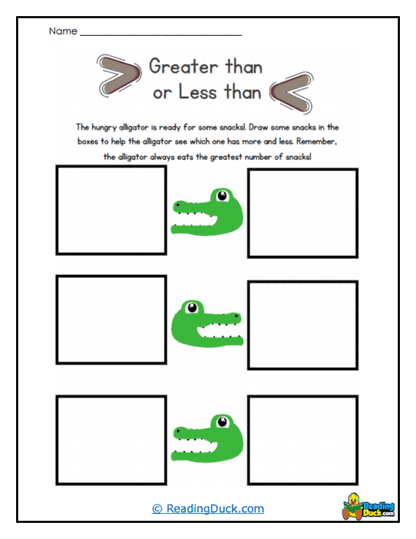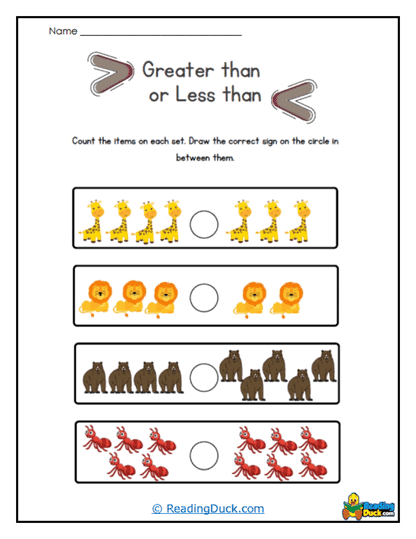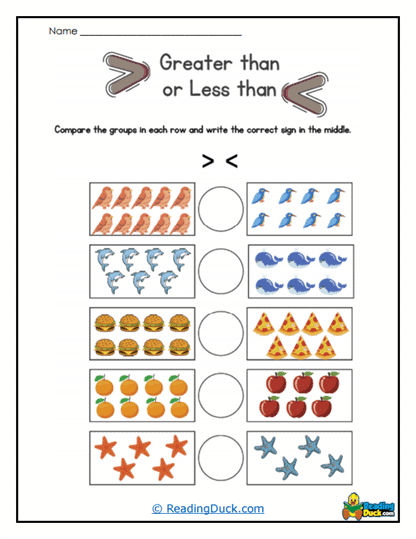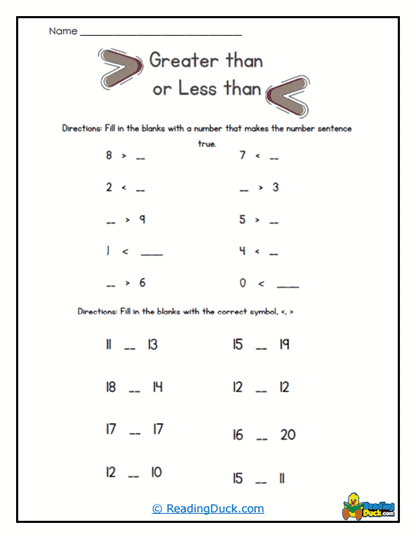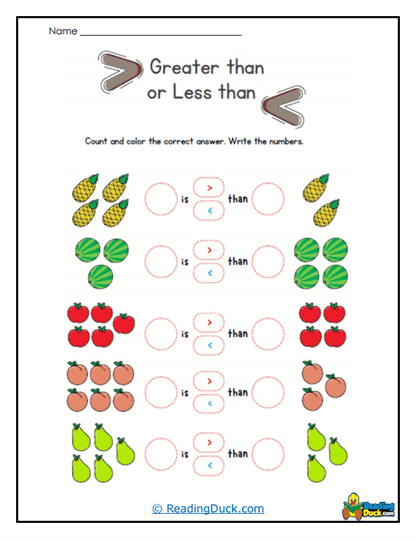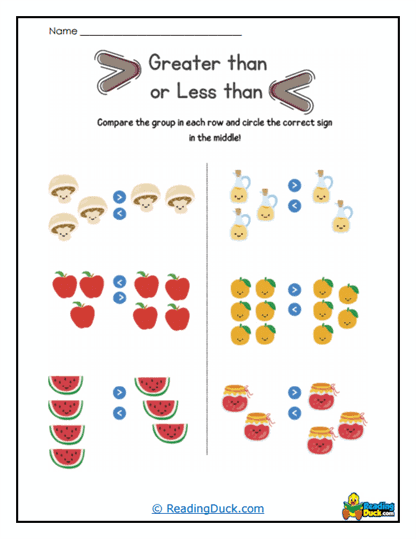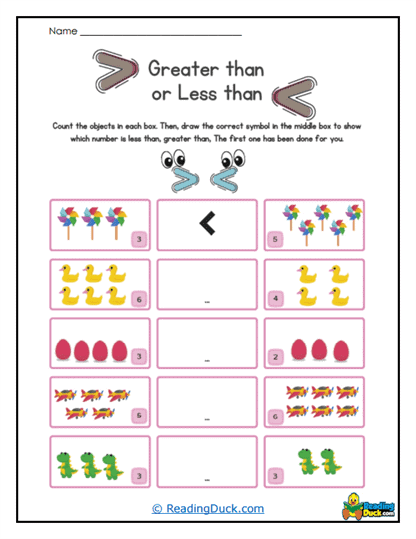Greater or Less Than Worksheets
About Our Greater or Less Than Worksheets
These worksheets will help young students understand numerical relationships by comparing values. These worksheets teach students how to identify whether a number is greater than, less than, or equal to another number using symbols like ">" for greater than, "<" for less than, and "=" for equal to. Such worksheets are fundamental in early math education, as they lay the groundwork for number sense, enabling students to confidently interpret and analyze numerical information. By recognizing and using these symbols, children develop a strong foundation for more advanced mathematical concepts.
The exercises depicted in these worksheets utilize both visuals and numbers to make learning engaging and accessible. For instance, many of the worksheets use pictures of objects, animals, or other familiar symbols to demonstrate quantity, making it easier for students to grasp the abstract concept of comparison. By counting objects or comparing numbers side-by-side, students can visually see which number or group is larger or smaller. Additionally, the worksheets often employ friendly graphics like cartoon animals, such as alligators facing the larger number, which helps students remember which symbol to use when comparing two values.
This set of greater or less than worksheets are particularly useful for young learners who are just beginning to engage with numbers beyond simple counting. The varied exercises ensure that students can practice comparing different types of numbers, from single digits to larger two-digit numbers. This variety keeps students engaged while progressively challenging them as they develop their skills. For educators and parents, these worksheets offer a structured and approachable way to introduce comparison, making it less intimidating and more relatable to children’s everyday experiences.
Using symbols to represent numerical relationships is a critical step in mathematical understanding. These worksheets do more than teach comparison; they enhance a child’s ability to think logically about numbers and make quick, informed decisions. Over time, greater or less than worksheets encourage students to internalize these symbols, allowing them to instinctively recognize relationships between numbers in various settings. This foundation is essential for future mathematical learning, including topics like place value, addition, and subtraction.
Formats
They come in a variety of formats, each tailored to reinforce specific comparison skills. One common exercise involves simple number comparisons, where students look at two numbers side by side and choose the appropriate symbol ("<", ">", or "="). For example, in one worksheet, students might compare the numbers 40 and 45, marking the symbol that correctly represents the relationship. This type of exercise reinforces number recognition and helps students begin comparing larger values confidently.
Another type of exercise includes visual comparison tasks where students count and compare sets of objects instead of written numbers. For instance, some worksheets may show groups of stars, animals, or toys, asking students to determine which group has more or fewer items. This type of visual comparison helps students who are still developing number recognition and counting skills, as they can rely on their ability to count objects to arrive at the correct answer. It is particularly effective for visual learners who benefit from tangible examples.
Many worksheets also feature exercises where students are asked to compare numbers within a themed setting, such as apples or toys. This approach uses relatable objects to make comparisons more engaging, often incorporating themed graphics to attract students' interest. By associating numbers with familiar objects, students find it easier to grasp abstract numerical concepts and may be more enthusiastic about practicing these skills.
Some worksheets integrate multiple comparison tasks in a sequence, progressively increasing in difficulty. For instance, students might start by comparing single-digit numbers and then move on to double-digit comparisons. This gradual increase helps build their confidence and prepares them for more complex mathematical operations. By offering a mix of number and object comparisons, as well as exercises of varying difficulty levels, these worksheets cater to diverse learning needs and provide comprehensive practice in comparison.
Skills That We Review
Completing these worksheets allows students to develop several key mathematical and cognitive skills. First and foremost, these worksheets enhance number sense, an essential skill for understanding mathematical relationships. By repeatedly comparing numbers, students start to recognize the relative size of numbers intuitively. This number sense forms the basis for more complex math topics such as addition, subtraction, and beyond.
Through comparison exercises, students also improve their critical thinking and decision-making skills. Each comparison requires students to analyze two values and make a judgment on their relationship, which fosters logical thinking. This process of comparing, analyzing, and deciding hones their ability to think critically and assess information, skills that are valuable in both math and other areas of learning.
Greater or less than worksheets also help build students' confidence in handling numbers. By mastering simple comparison tasks, students gain a sense of achievement and feel more comfortable working with numbers. This confidence is crucial, as a positive attitude towards math can impact a student’s long-term academic success. When students feel competent in foundational skills, they are more likely to approach new mathematical challenges with optimism and perseverance.
These worksheets develop a student’s attention to detail. Accurately comparing numbers requires focus and careful observation, especially as the worksheets increase in difficulty or present similar numbers side-by-side. Practicing such attention to detail strengthens their overall learning habits, as they learn to check their work and approach problems methodically. This careful approach is beneficial in all areas of study, promoting thoroughness and accuracy in their academic pursuits.
Real World Applications
The skills learned from greater or less than worksheets extend beyond the classroom, with practical applications in everyday life. For example, one of the most common uses of comparison skills is in financial literacy. When shopping, individuals constantly compare prices to make the best purchase decisions. A child who understands "greater than" and "less than" can apply this knowledge to compare product prices, helping them make informed decisions and understand value.
Measurement is another area where comparison skills are essential. In cooking or baking, for instance, it’s often necessary to determine if a quantity of an ingredient is greater or less than what a recipe requires. Knowing how to compare amounts accurately can be crucial to achieving the desired outcome. Children who practice comparison with numbers and objects on these worksheets are better prepared to use these skills in real-life measurement contexts.
Data analysis is a more advanced application where comparison skills are invaluable. In various fields, from science to social studies, people interpret data to draw conclusions. For instance, students may one day need to compare data points in a science experiment, such as comparing the growth of plants under different conditions. The foundational comparison skills gained from greater or less than worksheets set the stage for interpreting graphs, charts, and other data representations.
Comparison skills play a role in understanding and assessing personal progress. For instance, students may compare their test scores or sports performance over time to gauge improvement. Recognizing whether a new score is higher, lower, or equal to a previous one helps them set goals and understand their growth. This application of greater or less than skills fosters self-awareness and encourages students to set and achieve personal goals, a skill that is beneficial in both academic and personal development.
